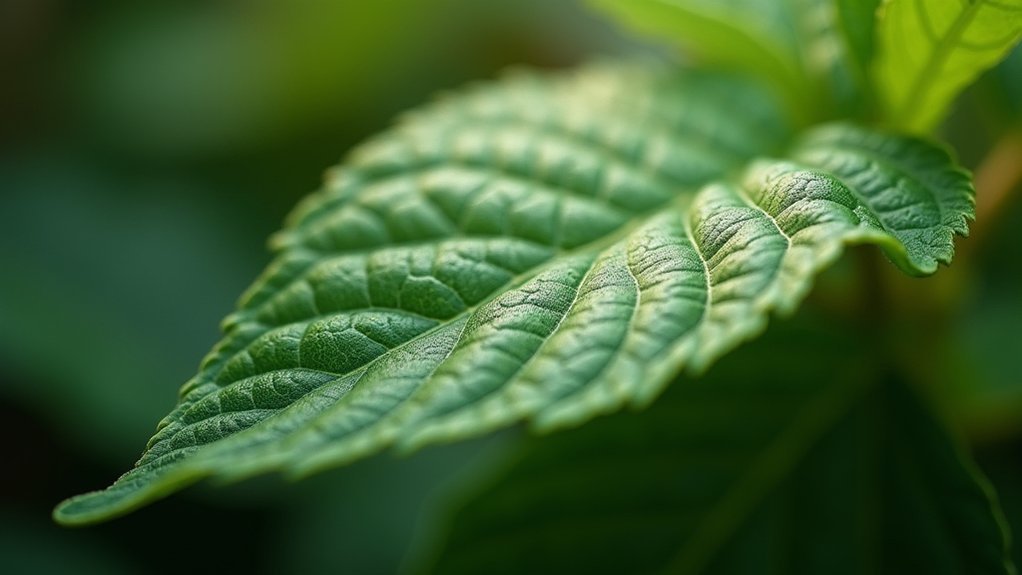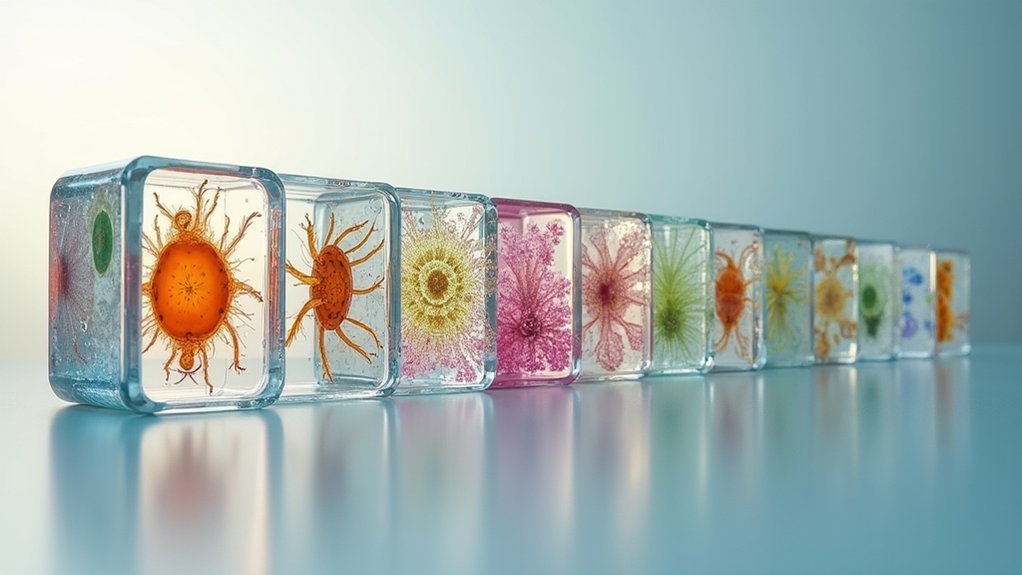To reduce noise in focus stacking, start with a sturdy tripod and low ISO (100-400) settings while shooting in RAW format. Use an intervalometer to capture consistent images and maintain identical exposure settings across your sequence. Apply median stacking techniques to naturally eliminate random noise while preserving critical edge details. For microscopy work, implement vibration control methods and consider specialized software like Helicon Focus or Zerene Stacker. The right combination of equipment setup and processing techniques will transform your stacked images.
Numeric List of Second-Level Headings

Three essential benefits come from using numbered headings in your image stack documentation.
First, they create a clear sequence for processing steps, helping you track your workflow when reducing noise in complex image stacking projects. You’ll never lose your place or skip vital steps that might compromise your final results.
Second, numbered headings make troubleshooting easier. When you encounter noise issues in your stacked images, you can quickly reference specific sections without confusion. This systematic approach saves valuable time during editing sessions.
Third, they improve collaboration. When sharing your workflow with other photographers, numbered sections provide common reference points for discussion. Your peers can precisely identify which noise reduction technique they’re asking about, making feedback more productive and implementation more accurate.
Understanding Noise Sources in Microscopy Images
When you’re working with microscopy images, you’ll encounter three primary noise sources that compromise image quality.
Electronic sensor noise creates a grainy appearance at high ISO settings, while ambient light interference introduces unwanted brightness variations that obscure fine details.
Your specimens may also generate autofluorescence issues, where natural fluorescence from biological materials competes with your target signals and reduces contrast in fluorescence microscopy.
Electronic Sensor Noise
Despite advances in microscopy technology, electronic sensor noise remains an unavoidable challenge when capturing high-quality images. When stacking images for microscopy, you’ll encounter two primary noise types: shot noise from photon quantization and read noise from sensor circuitry.
To achieve effective noise reduction in your stacked images:
- Cool your sensor to minimize thermal fluctuations, especially during long exposures or low-light captures.
- Select appropriate gain settings that balance signal amplification without excessive noise enhancement.
- Utilize dark frames for calibration to quantify and subtract inherent sensor noise.
Remember that noise is particularly problematic in low-light conditions where thermal fluctuations cause random pixel intensity variations.
Ambient Light Interference
External light sources infiltrating your microscopy setup can severely compromise image quality, even when electronic sensor noise has been properly managed. Ambient light from fluorescent fixtures or windows introduces inconsistent illumination, varying in both intensity and color temperature throughout your imaging session.
| Light Source | Impact | Mitigation Strategy |
|---|---|---|
| Fluorescent | Flicker and color shifts | LED replacement |
| Natural Light | Variable intensity | Light-tight enclosures |
| Room Lighting | Background noise | Strategic shielding |
For effective noise reduction, implement controlled lighting conditions using adjustable LED illumination systems. Create a light-tight environment by employing black enclosures around your microscope setup. Understanding the spectral characteristics of ambient interference will help you select appropriate filters to enhance image clarity. This approach guarantees consistent illumination across your focus stack, resulting in cleaner composite images with improved detail preservation.
Specimen Autofluorescence Issues
While controlling ambient light improves your imaging environment, a more challenging source of noise often comes from within the specimen itself.
Autofluorescence occurs when natural components in your specimen emit light upon excitation, creating unwanted background noise in your focus stacks.
For effective noise reduction when dealing with autofluorescent specimens:
- Select appropriate excitation and emission filters to minimize interference from cellular components like chlorophyll and lipofuscin
- Reduce exposure times and lower laser power when possible to prevent overwhelming your target signals
- Consider advanced techniques like spectral unmixing to separate autofluorescence from your fluorophores of interest
Equipment Requirements for Clean Focus Stacking
Five essential pieces of equipment form the foundation of successful focus stacking.
You’ll need a sturdy tripod to maintain your camera’s position across multiple exposures, preventing alignment issues that can ruin your stack. Always shoot in RAW file format to preserve maximum detail and dynamic range for post-processing.
An intervalometer automates your capture sequence, ensuring consistent timing between shots for better alignment.
Choose a camera with reliable autofocus capabilities to precisely target different depth layers without introducing unwanted movement.
Finally, select a lens that performs well at narrow apertures like f/8 or f/11, enhancing your depth of field while maintaining sharpness.
These apertures provide more distinct focus layers to combine into your final composite image.
Optimal Camera Settings to Minimize Initial Noise

Since noise reduction begins at capture, not in post-processing, configuring your camera correctly is essential for clean image stacks.
Keep your ISO between 100-400 to maintain high image quality while reducing noise that stacking can’t fully eliminate. Always shoot in RAW format to preserve maximum detail for post-processing.
Minimize capture noise by shooting at low ISO and in RAW format—stacking software can’t fix what’s already degraded.
- Mount your camera on a sturdy tripod to prevent subtle movements that introduce alignment issues and additional noise in your stacked images.
- Select a medium aperture (f/5.6-f/8) for ideal sharpness without compromising image quality through diffraction.
- Enable your camera’s long exposure noise reduction feature to automatically subtract dark frames from your captures.
These settings create the cleanest possible base images, giving your stacking software the best data to work with for superior final results.
Preparing Your Microscope for Multi-Image Capture
Proper alignment of your microscope’s optical components is critical for capturing clean, artifact-free images that will stack effectively.
You’ll need to secure your microscope on a vibration-isolating platform, using dampening materials or specialized anti-vibration tables to eliminate subtle movements that can blur your images.
Consider implementing remote shutter release or timed captures to further reduce vibration risks when working at high magnifications.
Microscope Alignment Essentials
Achieving exceptional image stacks begins with meticulous microscope preparation. Proper alignment is fundamental when stacking multiple images, as even minor misalignments can result in blurred or distorted final results.
Mount your microscope on a stable platform to eliminate vibrations that compromise alignment during capture.
For ideal microscope alignment:
- Regularly calibrate your optical path to guarantee accurate imaging and consistent results across all focus points.
- Install a mechanical stage or motorized focus system to precisely control the incremental movements between images.
- Select imaging software that offers fine-tuned control over focus and exposure settings.
Don’t overlook the importance of adjusting focus incrementally between captures to maintain a consistent depth of field—this attention to detail will greatly enhance your stacked images’ clarity and resolution.
Vibration Control Techniques
While alignment sets the foundation for excellent imaging, vibration management determines whether your stacked images will be pristine or plagued with blur. For effective vibration control, place your microscope on a stable, vibration-free surface that won’t compromise your stacking method.
Consider adding vibration isolation pads or using specialized tables that absorb external shocks, creating a more stable imaging environment.
When capturing multiple images, use a remote or timed shutter release to eliminate camera shake from manual handling—particularly essential at higher magnifications.
Move deliberately when adjusting focus or switching objectives to minimize potential disruptions.
For serious microscopy work, invest in a microscope with built-in vibration control features like active damping systems. These technologies greatly enhance image quality, ensuring your stacked results maintain perfect alignment.
Step-by-Step Image Acquisition Workflow

For successful focus stacking, a methodical approach to image capture is essential.
Begin with your camera mounted on a sturdy tripod to eliminate movement between shots—this consistency is vital for clean image stacking results.
Use an intervalometer to automate capturing multiple frames while maintaining identical settings across all images:
- Set consistent exposure parameters (aperture, ISO, white balance) for seamless blending
- Capture a complete series of images with focus points spanning the entire depth of your subject
- Keep your camera absolutely stationary throughout the entire process
After shooting, import your series into stacking software like Photoshop, Helicon Focus, or Zerene Stacker.
These programs will align and blend your images, creating a final composition with extended depth of field and minimal noise.
Advanced Alignment Techniques for Microscopic Subjects
The microscopic world presents unique challenges when creating focus stacks. When working at high magnifications, even minimal movement can drastically affect your results, making proper alignment essential for removing noise in your stacked image.
Invest in specialized software with high-precision algorithms designed specifically for microscopic subjects. These programs use feature matching to identify and align specific points across multiple frames, markedly enhancing detail clarity.
Maintain consistent lighting and exposure settings throughout your capture session to simplify the alignment process. Consider using a focus stacking rail for precise incremental adjustments between shots.
For post-processing, tools like Helicon Focus or Zerene Stacker automatically correct slight shifts between images, resulting in cleaner stacks with minimal artifacts.
These software solutions can detect and align even the smallest details that might be invisible to the naked eye.
Software Comparison for Microscope Image Stacking

Most microscope focus stacking projects demand specialized software that can address the unique challenges of microscopic subjects.
When selecting your stacking solution, you’ll need to evaluate each option’s capabilities for handling the fine details critical in microphotography.
- Helicon Focus excels with advanced algorithms for blending focal planes and offers integrated sharpening and noise reduction tools that preserve detail in raw files.
- Zerene Stacker provides superior alignment precision for complex specimens, making it ideal when you’re working with subjects that require exact pixel-level registration.
- Adobe Photoshop includes stacking functionality but typically lacks the specialized optimization found in dedicated software, though it does offer familiar raw processing workflows.
Your choice should ultimately depend on processing speed requirements, ease of use, and the level of control you need over the final stacked image.
Reducing Artifacts During the Stacking Process
While creating impressive microscope image stacks demands technical skill, preventing artifacts requires systematic attention to detail. You’ll need to maintain identical exposure settings—ISO, aperture, and shutter speed—across all images to guarantee consistency when you use stacking techniques to remove noise.
A sturdy tripod is non-negotiable for eliminating camera movement that leads to misalignment artifacts. Verify your subject remains completely static; even subtle motion can create ghosting or blurring in your final composite.
When processing your images, implement median blending methods to average pixel values and eliminate outlier data that contributes to artifacts.
Finally, don’t rush the alignment phase—carefully review and adjust settings in your stacking software to address minor positional differences between captures. These methodical steps will dramatically improve your final stacked image quality.
Post-Processing Methods for Further Noise Reduction

Even after successful image stacking eliminates most noise, you’ll often need additional refinement to achieve truly professional results.
To reduce noise while preserving critical details, consider these specialized techniques:
- Apply selective noise reduction in Lightroom or Photoshop using layer masks to target problematic areas while protecting textures and edges in your stacked images.
- Leverage advanced AI tools like DXO Deep Prime or Topaz AI for more precise control over noise reduction without compromising image quality.
- Combine careful sharpening with your noise reduction workflow to enhance clarity without introducing unwanted artifacts.
For best results, export your processed images as 16-bit TIFFs to retain maximum detail for any future adjustments.
This balanced approach guarantees your stacked images maintain their integrity while achieving that clean, professional look you’re aiming for.
Balancing Detail Preservation and Noise Elimination
When optimizing your signal-to-noise ratio in stacked images, you’ll need to carefully evaluate which details must be preserved and which noise patterns can be eliminated.
Selective detail masking allows you to protect texture-rich areas while aggressively reducing noise in smoother regions, creating a more balanced final image.
Edge preservation techniques, such as using higher threshold values near high-contrast boundaries, help maintain the crispness of important details while still removing unwanted noise throughout your composite photograph.
Signal-to-Noise Ratio Optimization
Although achieving perfect image clarity seems elusive, optimizing your signal-to-noise ratio (SNR) is the key to balancing detail preservation with noise reduction.
When stacking images, capture several exposures with consistent camera settings—particularly use iso values that remain unchanged throughout your sequence.
For maximum SNR benefits in your stacked images:
- Apply median stacking methods to effectively eliminate outlier noise values while preserving important signal details
- Maintain identical aperture, shutter speed, and ISO across all frames to guarantee uniform signal characteristics
- Capture at least five distinct exposures to greatly reduce random noise patterns while retaining fine details
Selective Detail Masking
While noise reduction techniques effectively clean up your stacked images, selective detail masking represents the vital next step in preserving image integrity.
You’ll need to apply noise reduction selectively, targeting problematic areas while protecting critical details.
Using layers and masks in your editing software, you can reduce noise in smooth areas like skies or shadows without compromising sharp edges and textures.
Control your brush tool to paint noise reduction only where needed—apply gradients for shifting areas for natural-looking results.
Remember that balance is essential; excessive smoothing will destroy the fine details you worked so hard to capture.
Combine selective detail masking with stacking techniques to achieve images that maintain both clarity and authentic texture, particularly important in landscape and macro photography where detail preservation is paramount.
Edge Preservation Techniques
Building on your selective masking skills, edge preservation stands as the cornerstone of high-quality image stacking. When you effectively implement edge preservation techniques, you’ll reduce noise while maintaining the critical details that define your subject.
Median stacking offers a powerful starting point, selecting middle values from pixel stacks to naturally preserve edges while eliminating random noise.
For ideal results:
- Combine multiple stacking approaches—use median stacking for noise reduction and high-pass filtering for edge enhancement
- Apply selective noise reduction with different settings for high-frequency (edge) details versus smooth areas
- Utilize edge-aware algorithms in advanced software that intelligently protect important features during processing
You’ll achieve the perfect balance between noise elimination and detail preservation by treating edges differently from smooth areas, resulting in cleaner, sharper stacked images with authentic-looking details.
Frequently Asked Questions
Does Focus Stacking Reduce Noise?
Yes, focus stacking does reduce noise. When you combine multiple exposures, you’re averaging out random noise patterns, resulting in a cleaner final image while also gaining the benefit of extended depth of field.
How to Stack Images in Photoshop to Reduce Noise?
To stack images in Photoshop to reduce noise, you’ll need to import aligned layers, convert to a smart object, apply median stack mode, and adjust layer opacities for best results. Save as TIFF when finished.
How to Reduce Noise in Image Processing?
To reduce noise in image processing, you’ll get the best results by stacking multiple distinct exposures. Capture several images, import them as layers in editing software, align them properly, and merge using median stack mode.
How Do Image Stacks Improve Image Quality?
Image stacks improve quality by averaging out random noise across multiple exposures. You’ll get clearer results as varying noise patterns cancel each other, preserving fine details while enhancing dynamic range and tonal quality.
In Summary
You’ve now learned the complete focus stacking workflow for cleaner microscopy images. By addressing noise at each stage—from proper equipment setup to ideal capture settings and intelligent software choices—you’ll create stacks with remarkable clarity. Remember, it’s a balancing act between noise reduction and detail preservation. With practice, you’ll develop an intuitive feel for the perfect balance in your microscopy work.





Leave a Reply